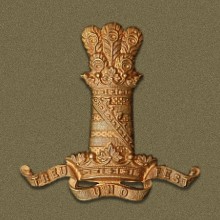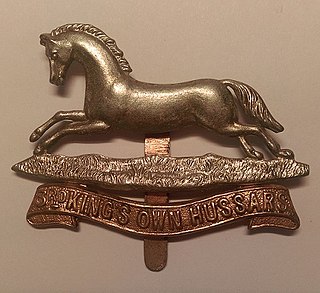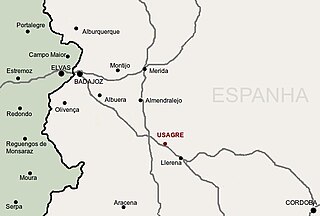Related Research Articles

The 11th Hussars (Prince Albert's Own) was a cavalry regiment of the British Army established in 1715. It saw service for three centuries including the First World War and Second World War but then amalgamated with the 10th Royal Hussars (Prince of Wales' Own) to form the Royal Hussars in 1969.

The 10th Royal Hussars (Prince of Wales's Own) was a cavalry regiment of the British Army raised in 1715. It saw service for three centuries including the First World War and Second World War but then amalgamated with the 11th Hussars (Prince Albert's Own) to form the Royal Hussars (Prince of Wales's Own) in October 1969.

The 13th Hussars was a cavalry regiment of the British Army established in 1715. It saw service for three centuries including the Napoleonic Wars, the Crimean War and the First World War but then amalgamated with the 18th Royal Hussars, to form the 13th/18th Royal Hussars in 1922.

The 14th King's Hussars was a cavalry regiment in the British Army, first raised in 1715. It saw service for two centuries, including the First World War, before being amalgamated with the 20th Hussars to form the 14th/20th King's Hussars in 1922.

The 18th Royal Hussars (Queen Mary's Own) was a cavalry regiment of the British Army, first formed in 1759. It saw service for two centuries, including the First World War before being amalgamated with the 13th Hussars to form the 13th/18th Royal Hussars in 1922.

The 3rd Hussars was a cavalry regiment of the British Army, first raised in 1685. It saw service for three centuries, including the First and the Second World Wars, before being amalgamated with the 7th Queen's Own Hussars, to form the Queen's Own Hussars in November 1958.

The 4th Queen's Own Hussars was a cavalry regiment in the British Army, first raised in 1685. It saw service for three centuries, including the First World War and the Second World War. It amalgamated with the 8th King's Royal Irish Hussars, to form the Queen's Royal Irish Hussars in 1958.

The 15th The King's Hussars was a cavalry regiment in the British Army. First raised in 1759, it saw service over two centuries, including the First World War, before being amalgamated with the 19th Royal Hussars into the 15th/19th The King's Royal Hussars in 1922.

The 7th Queen's Own Hussars was a cavalry regiment in the British Army, first formed in 1689. It saw service for three centuries, including the First World War and the Second World War. The regiment survived the immediate post-war reduction in forces, but following the 1957 Defence White Paper, it was amalgamated with the 3rd The King's Own Hussars, forming the Queen's Own Hussars in 1958.

The Duchess of Richmond's Ball was a ball hosted by Charlotte Lennox, Duchess of Richmond in Brussels on 15 June 1815, the night before the Battle of Quatre Bras. Charlotte's husband Charles Lennox, 4th Duke of Richmond, was in command of a reserve force in Brussels, which was protecting that city in case Napoleon Bonaparte invaded.

Lieutenant-General Robert Ballard Long was an officer of the British and Hanoverian Armies who despite extensive service during the French Revolutionary and Napoleonic Wars never managed to achieve high command due to his abrasive manner with his superiors and his alleged tactical ineptitude. Although he remained a cavalry commander in the Peninsular War between 1811 and 1813, the British commander Wellington became disillusioned with Long's abilities. Wellington's opinion was never expressed directly, though when the Prince Regent manoeuvred his favourite, Colquhoun Grant into replacing Long as a cavalry brigade commander, Wellington conspicuously made no effort to retain Long. Other senior officers, including Sir William Beresford and the Duke of Cumberland, expressed their dissatisfaction with Long's abilities. The celebrated historian, and Peninsula veteran, Sir William Napier was a severe critic of Beresford's record as army commander during the Albuera Campaign; in criticising Beresford he involved Long's opinions as part of his argument. The publication of Napier's history led to a long running and acrimonious argument in print between Beresford and his partisans on one side, with Napier and Long's nephew Charles Edward Long on the other. Recently, Long's performance as a cavalry general has received more favourable comment in Ian Fletcher's revisionist account of the British cavalry in the Napoleonic period.

In the Battle of Usagre on 25 May 1811, Anglo-Allied cavalry commanded by Major-General William Lumley routed a French cavalry force led by Major-General Marie Victor Latour-Maubourg at the village of Usagre, Spain, in the Peninsular War.

In the Battle of Villagarcia on 11 April 1812, British cavalry commanded by Lieutenant-General Sir Stapleton Cotton routed a French cavalry force led by Général de Brigade Charles Lallemand at the village of Villagarcia in the Peninsular War. Cotton intended to trap the French cavalry, which was separated by a number of miles from the main body of the French army, by executing simultaneous frontal and flank attacks. The plan came close to disaster when the forces making the frontal assault pushed forward prematurely. The situation was saved by the timely arrival of John Le Marchant's force on the French left flank.
The 4th Cavalry Brigade was a cavalry brigade of the British Army. It served in the Napoleonic Wars, in the First World War on the Western Front where it was initially assigned to The Cavalry Division before spending most of the war with the 2nd Cavalry Division, and with the 1st Cavalry Division during the Second World War.
The 5th Cavalry Brigade was a cavalry brigade of the British Army. It served in the Napoleonic Wars, in the First World War on the Western Front where it was initially independent before being assigned to the 2nd Cavalry Division, and with the 1st Cavalry Division during the Second World War.
The 6th Cavalry Brigade was a cavalry brigade of the British Army. It served in the Napoleonic Wars, in the First World War on the Western Front where it was assigned to the 3rd Cavalry Division, and with the 1st Cavalry Division during the Second World War.
Lieutenant General Sir John Colquhoun Grant was a British soldier.

The regimental depot of a regiment is its home base for recruiting and training. It is also where soldiers and officers awaiting discharge or postings are based and where injured soldiers return to full fitness after discharge from hospital before returning to full duty. Normally, a variety of regimental stores will also be kept at the depot. The regimental depot is not the same as the regimental headquarters, though in practice the two will often be co-located.

In the Battle of Campo Maior, or Campo Mayor, on 25 March 1811, Brigadier General Robert Ballard Long with a force of Anglo-Portuguese cavalry, the advance-guard of the army commanded by William Beresford, clashed with a French force commanded by General of Division Marie Victor de Fay, marquis de Latour-Maubourg. Initially successful, some of the Allied horsemen indulged in a reckless pursuit of the French. An erroneous report was given that they had been captured wholesale. In consequence, Beresford halted his forces and the French were able to escape and recover a convoy of artillery pieces.

Colonel Sir Felton Elwell Hervey-Bathurst, 1st Baronet,, was an officer in the British Army during the Napoleonic Wars.
References
- 1 2 3 4 5 Brown, Steve. "British Cavalry Regiments and the Men Who Led Them 1793-1815: 7th Light Dragoons (Hussars)".
- 1 2 "Derbyshire Postcards - Birchover".
- 1 2 3 4 5 6 7 8 "William Thornhill".
- ↑ Foster, Ray. "Notes on Wellington's Cavalry in the Peninsula: 7th Hussars (Queens Own)".
- ↑ Historical Record of the Seventh, or the Queen's Own Regiment of Hussars. London: John W. Parker. 1842. p. 77. Retrieved 23 December 2024– via Project Gutenberg.
- ↑ "ArtUK entry".